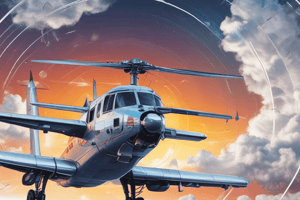Podcast
Questions and Answers
What is the primary benefit of examining historical case studies of radar returns for pilots?
What is the primary benefit of examining historical case studies of radar returns for pilots?
- Identifying the specific types of radar equipment used by various airlines and airports.
- Developing strategies for avoiding weather disruptions during flight planning.
- Learning to interpret radar data and predict the behavior of weather systems. (correct)
- Understanding the limitations of radar technology and how it can be inaccurate.
What is the main reason why pilots should cross-reference radar data with other weather information sources?
What is the main reason why pilots should cross-reference radar data with other weather information sources?
- To confirm the accuracy of radar data, as it can sometimes be unreliable.
- To ensure compliance with aviation regulations and safety standards.
- To identify potential conflicts with other aircraft in the vicinity.
- To gain a more comprehensive understanding of the current meteorological conditions. (correct)
Which of the following is NOT a key consideration when evaluating the usefulness of PIREPs for flight planning?
Which of the following is NOT a key consideration when evaluating the usefulness of PIREPs for flight planning?
- The age of the PIREP, as the weather conditions may have changed significantly since the report was filed.
- The correlation between the PIREP's observations and other weather advisories and forecasts.
- The pilot's experience and qualifications, as this can affect the reliability of the report.
- The specific type of aircraft that reported the weather, as it can influence the accuracy of the observations. (correct)
What is the primary purpose of SIGMETs and Convective SIGMETs for pilots?
What is the primary purpose of SIGMETs and Convective SIGMETs for pilots?
How do case studies of SIGMETs and Convective SIGMETs help pilots in flight planning?
How do case studies of SIGMETs and Convective SIGMETs help pilots in flight planning?
Which of the following is NOT a potential adjustment to a flight plan that a pilot might make in response to a SIGMET?
Which of the following is NOT a potential adjustment to a flight plan that a pilot might make in response to a SIGMET?
What is the most significant difference between PIREPs and SIGMETs?
What is the most significant difference between PIREPs and SIGMETs?
Why is it important for pilots to consider the time-sensitive nature of PIREPs?
Why is it important for pilots to consider the time-sensitive nature of PIREPs?
Which of the following best describes the role of case studies in pilot training for weather awareness?
Which of the following best describes the role of case studies in pilot training for weather awareness?
What is the primary goal of integrating weather information from various sources, such as radar, PIREPs, and SIGMETs?
What is the primary goal of integrating weather information from various sources, such as radar, PIREPs, and SIGMETs?
Flashcards are hidden until you start studying
Study Notes
Real-World Weather Scenario Analysis
- Flight decision-making is heavily influenced by accurate assessment and response to weather information.
- Understanding weather data involves interpreting the stories behind the numbers to make informed choices.
Importance of Radar Imagery
- Radar imagery provides critical insights into storm patterns, movement, and intensity, acting as an essential tool for pilots.
- Detecting squall lines through radar can prevent encounters with severe turbulence.
Role of PIREPs
- Pilot Weather Reports (PIREPs) are invaluable real-time observations shared among pilots for flight safety.
- Analyzing PIREPs enables pilots to gauge current conditions like turbulence and icing, enhancing situational awareness.
Understanding SIGMETs and Convective SIGMETs
- SIGMETs alert pilots to severe weather phenomena such as thunderstorms, tornadoes, and volcanic ash, impacting flight planning.
- Awareness of SIGMET information allows pilots to anticipate weather changes and adjust flight paths accordingly.
Case Study Example
- A flight from Chicago to Atlanta receives a convective SIGMET indicating severe thunderstorms near the route.
- The pilot integrates radar imagery and PIREPs to request a route change from ATC, prioritizing passenger safety and comfort.
Importance of Integrating Weather Data
- Comprehensive analysis combines radar, satellite data, and human observations for effective decision-making.
- Utilizing various weather reports (METARs, TAFs, AIRMETs, SIGMETs) is essential for a thorough understanding of meteorological conditions.
Strategies for Effective Weather Assessment
- Pilots must critically evaluate scenarios for improvement and recognize successful strategies for utilizing weather information.
- Continuous learning and critical thinking about weather impacts ensure ongoing safety and efficiency in flight operations.
Decision-Making in Severe Weather
- Accurate radar interpretation can help pilots avoid hazardous conditions like intense precipitation and thunderstorms.
- Understanding the practical application of weather advisories is crucial in navigating the complexities of flight operations.
Key Learning Outcomes
- Radar imagery is vital for identifying hazardous weather conditions.
- PIREPs enhance knowledge of current flight conditions through direct pilot observations.
- SIGMETs are essential for recognizing and anticipating severe weather changes.
Future Learning Focus
- The next session will explore applying case studies to flight planning, integrating real-world insights for practical preparations.
- Emphasis on adapting strategies for managing severe weather will be a key educational goal in upcoming lectures.
Studying That Suits You
Use AI to generate personalized quizzes and flashcards to suit your learning preferences.




